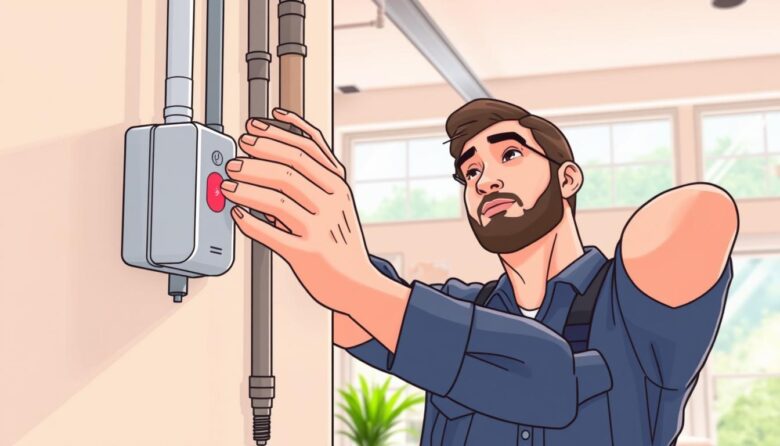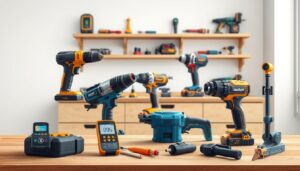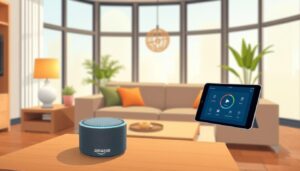Water damage is a serious threat to any property. In fact, statistics show it is six times more common than theft and eight times more frequent than fire. This type of problem affects nearly 40% of all homes, making it a widespread concern for owners.
Protecting your investment requires a proactive approach. Modern technology offers powerful solutions to monitor your plumbing system. These smart devices can identify issues early, often long before you would notice a problem yourself.
The financial benefits are significant. Advanced systems like the Flo Smart Water Shutoff have been shown to reduce water damage claim events by an impressive 96%. This represents substantial savings compared to the high cost of emergency repairs and restoration.
Many property owners are unaware of hidden leaks. Remarkably, about 60% of users discover an existing water leak within the first 30 days of installing a new monitoring system. This early detection is key to preventing major damage to your home.
This guide will explore the best options available to safeguard your property. Understanding the technology empowers you to make an informed decision and effectively manage risk.
An Overview of Leak Detection Technologies
Modern property protection relies on sophisticated monitoring systems that employ various sensing approaches. These technologies work together to identify potential issues before they escalate into major problems.
Probe-based units feature metal contacts that complete electrical circuits when moisture bridges the gap. This triggers immediate alerts when water is detected. The system responds quickly to prevent extensive damage.
Cable-length monitoring extends coverage across larger areas. These devices incorporate sensing capabilities throughout their entire length. They are ideal for watching multiple appliances or extensive pipe runs.
Advanced systems integrate pressure monitoring and flow rate analysis. They track temperature variations to spot anomalies indicating potential issues. This multi-layered approach provides comprehensive protection.
Wireless connectivity options enable real-time communication with central hubs. Systems use Wi-Fi, Zigbee, and proprietary protocols for instant smartphone notifications. This ensures prompt response to any detected problems.
Modern units combine multiple detection methods with intelligent algorithms. They learn normal water usage patterns and identify deviations. Understanding these core technologies helps property owners select appropriate systems.
Why Installing Leak Detectors is Essential
Many homeowners are unaware of the silent threats lurking within their walls and under their appliances. A small, persistent drip from a pipe or a faulty appliance can go unnoticed for months. This hidden problem wastes a tremendous amount of water—amounting to thousands of gallons annually.
The financial impact is severe. Water damage from burst pipes and slow leaks is one of the most expensive home insurance claims. Repair costs often exceed tens of thousands of dollars.
Early intervention is critical. It stops secondary issues like mold growth, wood rot, and foundation problems. These complications emerge when moisture infiltration is not caught quickly.
Homes are full of potential trouble spots. Key areas to monitor include:
- Water heaters and washing machines
- Dishwashers and refrigerator ice makers
- Sump pumps and the extensive network of pipes
For those who travel or manage rental properties, the risk is even greater. Issues can progress for weeks without anyone present. Continuous monitoring provides a level of security that periodic human checks cannot match.
This constant vigilance offers significant peace of mind. It is a powerful financial safeguard against catastrophic property damage events.
How Automated Leak Detectors Prevent Costly Water Damage
Continuous monitoring technology offers a powerful defense against one of the most expensive home disasters. These intelligent devices work around the clock to identify moisture issues before they escalate.
Understanding Hidden Water Damage Risks
Many property issues develop silently behind walls and under floors. Slow drips from aging copper pipes or failing appliance connections often go unnoticed for months.
This hidden moisture leads to structural deterioration over time. Mold growth and wood rot become serious concerns when problems remain undetected.
Common trouble spots include:
- Pinhole leaks in aging plumbing
- Deteriorating washing machine hoses
- Failing water heater connections
Case Studies of Leak Prevention Success
Real-world data demonstrates the effectiveness of modern monitoring solutions. A 2020 study of 2,306 U.S. homes revealed impressive results.
The Flo Smart Water Shutoff reduced water damage claim events by 96%. This represents substantial financial protection for property owners.
Remarkably, 60% of homeowners discovered previously unknown issues within the first 30 days of installation. Early identification prevents minor problems from becoming major repairs.
Addressing a small moisture issue costs hundreds of dollars. Extensive restoration from undetected water damage often reaches tens of thousands. The investment in protection pays for itself many times over.
Top-Rated Leak Detectors for Residential Properties
Homeowners seeking reliable water monitoring solutions will find several excellent residential-grade systems available. These devices offer varying features to match different home protection needs.
X-Sense Wi-Fi Water Leak Detector Kit Overview
The X-Sense system includes a central hub that connects four puck-shaped sensors to your home Wi-Fi. These units detect moisture within two seconds using both top and bottom probes.
This residential protection system provides multiple alert methods. It features an 86-decibel alarm, flashing lights, and sends notifications through its dedicated app. The system also monitors its own connectivity status.
Moen Smart and Aqara Water Leak Sensor Insights
Moen Smart units excel in tight spaces with their ultra-thin 0.26-inch design. Their unique cable detects water along its entire length, offering extended coverage options.
Aqara sensors provide Apple HomeKit support for integrated smart homes. While requiring a separate hub, they offer compact monitoring for residential applications. Both systems deliver reliable performance for home water protection.
These top residential options balance detection speed, alert reliability, and installation flexibility. Choosing the right system depends on your specific home layout and monitoring requirements.
Top Leak Detector Options for Commercial Spaces
Commercial properties face unique challenges when protecting against moisture intrusion. Large facilities require monitoring systems with expanded coverage and centralized management capabilities.
The Proteus Aquo represents a commercial-grade solution that addresses these needs. This system operates on wall outlet power for continuous operation, ensuring uninterrupted protection for high-value areas.
Facility managers can configure the Aquo through a web browser interface. The platform supports multiple notification methods including:
- Customizable 83-decibel audible buzzer alerts
- Email notifications for immediate awareness
- Phone calls and text message options
The system accommodates up to five different sensor types for comprehensive coverage. Available options include puck sensors for spot monitoring, cable-length detectors for extended pipe runs, and specialized sump-pump monitors.
Integration with Amazon Alexa, Google Home, and IFTTT enables incorporation into broader building automation systems. This connectivity allows commercial properties to create sophisticated protection networks.
Scalable configurations make the Aquo suitable for facilities of various sizes. From small offices to large complexes, this system provides reliable water detection where it matters most.
Reviewing High-Performance Smart Leak Detection Systems
The effectiveness of a smart water sensor hinges on its ability to deliver timely and multiple forms of alerts. Top-tier systems provide comprehensive protection through rapid detection and redundant notification methods.
X-Sense Performance and Multimodal Alerts
The X-Sense system exemplifies high-performance monitoring. It identifies water contact in just two seconds, enabling an immediate response.
This smart leak sensor uses a multimodal approach to ensure you are always informed. It triggers flashing LEDs, an 86-decibel alarm, push notifications, and email alerts simultaneously.
This redundancy is crucial. It guarantees awareness regardless of your location or phone status.
Govee vs YoLink: Feature Comparison
Govee’s Water Leak Detector 2 utilizes LoRa long-range wireless technology. This extends its range, making it ideal for large properties with weak Wi-Fi signals.
YoLink’s Water Leak Sensor 4 offers a key advantage with offline notifications. Its system can still send alerts during an internet outage, a significant benefit for reliability.
App interface quality also differs. YoLink often receives praise for its cleaner, more intuitive sensor management layout compared to some competitors.
Both units feature dual-probe designs for comprehensive detection. They monitor for water dripping from above or pooling from below.
Automated Leak Detectors: Features and Innovations
Today’s advanced monitoring devices represent a substantial leap forward in both sensing capabilities and communication technologies. These innovations provide more reliable protection against moisture issues in residential and commercial settings.
Advanced Sensor Technologies
Modern units feature dual-probe configurations with contacts on both top and bottom surfaces. This design detects water whether it drips, sprays, or pools around the device.
Detection sensitivity has improved dramatically. Leading sensors like the Aqara unit trigger alerts at water depths as shallow as 0.5mm. This ensures early warning before significant accumulation occurs.
Cable-length sensing technology extends coverage across larger areas. Instead of just endpoint probes, the entire cable contains water-sensitive materials. This provides comprehensive monitoring for pipe runs and appliance clusters.
Smart Connectivity Options
Wireless communication protocols have evolved to meet diverse property needs. Systems now offer multiple connection methods:
- LoRa technology enables long-range communication exceeding Wi-Fi limitations
- Zigbee mesh networking creates self-healing networks between multiple sensors
- Direct Wi-Fi connectivity simplifies installation without requiring additional hubs
Communication ranges now reach up to 200 meters with systems like Eufy. This allows sensor placement in detached structures and remote areas while maintaining reliable monitoring through your smartphone app.
These connectivity innovations balance range, power consumption, and reliability. They accommodate various property configurations and user technical capabilities for optimal water protection.
Enhancing Water Safety with Smart Home Integration>
Smart home compatibility transforms basic moisture sensors into intelligent components of a unified property protection network. This integration allows different devices to work together seamlessly. It creates a coordinated response system for maximum effectiveness.
When water monitoring devices connect to your smart ecosystem, they become more than just alert systems. They can trigger automated responses across your entire home. This creates a comprehensive defense strategy against potential water issues.
Integration with Alexa, Google Assistant, and Siri
Voice assistant compatibility varies significantly across different monitoring systems. Govee and YoLink units support Amazon Alexa for voice commands and routine automation. Aqara sensors work with Apple HomeKit, offering Siri integration for iOS users.
The Proteus Aquo commercial system integrates with both Amazon Alexa and Google Home. However, this requires a multistep configuration process. SwitchBot supports multiple platforms including Alexa, Google Assistant, and IFTTT.
Some capable systems like X-Sense and Moen lack smart home automation support. This limitation affects their appeal for users seeking unified management. Integration complexity ranges from simple one-tap setups to multistep processes.
Comprehensive smart water safety strategies leverage this connectivity effectively. They can automatically shut off water supplies or activate warning systems. This creates a proactive approach to home protection.
Installation Guidelines for Optimal Leak Detector Placement>
Strategic placement of your water monitoring equipment is crucial for maximum protection. Proper installation ensures your system can identify issues before they become major problems. Focus on areas where moisture problems commonly develop.
Start with high-risk locations beneath appliances and near pipes. These spots represent the greatest potential for water damage in your home. Key areas include spaces under water heaters, washing machines, and refrigerators with ice makers.
Basements deserve special attention since water flows downward. Lower-level spaces become vulnerable to damage from upper-floor issues. Foundation seepage can also create significant moisture problems in these areas.
Install comprehensive systems near your main shutoff valve. This placement allows for automatic water supply control during emergencies. It provides the strongest defense against catastrophic flooding events.
Modern slim designs measure between 0.26 and 0.59 inches thick. These compact sensors fit in tight spots under appliances. They expand coverage to previously unmonitored areas of your property.
Additional critical placement locations include:
- Bathroom toilet bases and vanity sink cabinets
- Sump pump areas during heavy rain events
- Utility rooms with exposed pipe runs
- Cable-length sensors for extended coverage
Avoid spots with routine condensation or cleaning activity. These locations can trigger false alarms and reduce system reliability. Proper placement ensures your investment delivers consistent protection.
Real-Time Alerts and Notification Systems>
Multi-channel alert systems provide redundancy to guarantee critical information reaches property owners. The speed and reliability of these notifications directly impact how quickly you can respond to potential issues.
Modern monitoring solutions offer various communication methods to ensure you never miss an important alert. Each approach serves different situations and user preferences.
Push, Email, and Device Notifications
Push notifications deliver instant alerts through dedicated mobile applications. Systems like Govee and YoLink use this method for rapid communication. X-Sense provides both push and email alerts for comprehensive coverage.
Email alerts serve as reliable backup channels. They create permanent records of events. Some systems like First Alert and SwitchBot include this feature alongside push notifications.
Phone-based alerts offer the most immediate attention. The Flo system can send text messages, emails, or direct calls. Proteus Aquo takes this further with customizable voice calls and WhatsApp messages.
SMS text messages work independently of app installations. AiDot includes this option for broader accessibility. This ensures alerts reach you even without internet connectivity.
Advanced systems allow customization of notification preferences. You can configure different alert methods based on severity or time of day. This multi-layered approach ensures maximum protection for your property.
Battery Life, Maintenance, and Testing of Leak Sensors>
Battery performance directly impacts the effectiveness of moisture detection systems. Proper care ensures your protection remains active when needed most. This section covers essential maintenance practices.
Understanding power sources helps you choose the right system for your needs. Different technologies offer varying operational periods.
Battery Performance Insights
Most water monitoring devices use standard battery types for convenience. First Alert L1 employs two AA batteries lasting up to two years. Eufy and SwitchBot units offer similar longevity with different battery sizes.
Compact sensors like Aqara and AiDot use CR2 lithium batteries. These provide extended life in smaller form factors. The Stitch by Monoprice system displays remaining power through its mobile app.
Wall-powered options like Proteus Aquo eliminate battery concerns. They require outlet access but provide continuous operation. Consider placement when choosing between battery and plug-in models.
Maintenance Best Practices
Regular testing ensures your system functions properly. Monthly checks with small water amounts verify detection capabilities. This simple routine prevents unexpected failures.
Sensor probes need occasional cleaning to maintain sensitivity. Dust and mineral deposits can interfere with water contact. Gentle wiping keeps components working effectively.
Document replacement dates and test results for consistency. Systems that alert when sensors go offline provide additional security. Proper maintenance guarantees reliable protection over time.
Comparing Leak Detectors: Performance, Alerts, and Integration>
When selecting water monitoring products, understanding the relationship between cost and capabilities is essential for making an informed purchase. The market offers a wide spectrum, from basic units to advanced systems with extensive features.
Price vs Features Analysis
Prices for these protective devices range dramatically. Budget-friendly options like the Ikea Badring start at around $12. Mid-range products from brands like Eufy and First Alert typically cost between $25 and $65.
Higher-priced systems offer more sophisticated alert methods. They often include multi-channel notifications like push, email, SMS, and even phone calls. Budget models may rely solely on app-based alerts.
Performance is a critical factor. Many affordable sensors offer detection speeds that rival premium units. A two-second response time is common across various price points.
Key considerations when comparing products include:
- Detection reliability and sensor technology
- Alert delivery methods and redundancy
- Smart home platform compatibility
- System expandability for future needs
Bundle packages often provide the best value. Systems like X-Sense and Govee include a hub with multiple sensors. This approach is cost-effective for comprehensive property coverage.
Effective Strategies to Prevent Water Damage>
Building a robust defense against potential water problems requires both regular inspections and emergency planning. This comprehensive approach goes beyond basic monitoring to address issues before they escalate.
Routine System Inspections
Regular checks of your plumbing infrastructure can identify aging components before failures occur. Inspect pipes, appliance connections, and seals for signs of wear.
Advanced monitoring systems use artificial intelligence to learn normal home water usage patterns. They detect unusual flow rates and extended run times that suggest developing issues.
Emergency Response Preparedness
Establish clear protocols for who receives alerts and where shutoff valves are located. This ensures quick action when problems arise.
Temperature monitoring provides freeze warnings before pipe bursts occur. Automatic shutoff capabilities represent the ultimate protection measure during significant events.
Regular inspection schedules for high-risk appliances prevent age-related failures. This proactive approach minimizes the need for reactive solutions.
User Experiences and Reliability Ratings
Independent testing reveals significant differences in how quickly various moisture sensors detect problems. Real-world evaluations show response times ranging from immediate alerts to noticeable delays.
Customer Reviews Highlights
Performance testing demonstrates clear winners among available options. The X-Sense system consistently detects water contact within two seconds, sending immediate alerts to its base station.
Govee and YoLink units perform reliably across all test scenarios. These devices offer balanced detection speed and app functionality. Users appreciate their consistent performance.
Some models show variable results depending on water application method. The AiDot sensor failed with slow drips but triggered when water pooled underneath. This highlights the importance of proper placement.
Cable-length sensors generally receive positive feedback for extended coverage. Users note faster detection along the entire cable length compared to single-point units.
App quality significantly impacts customer satisfaction. Clean interfaces receive praise while confusing layouts generate complaints. Alert delivery reliability remains a critical concern for all users.
Selecting the Ideal Leak Detector for Your Home or Business
Choosing the right protection system for your property involves matching technology to your specific environment and risk factors. Consider your building’s size, layout, and potential trouble spots. Your budget and existing smart home setup also play important roles in this decision.
Evaluating Sensor Types
Different monitoring units work best in various locations. Slim profile water sensors fit perfectly under appliances with limited clearance. They provide discreet protection in tight spaces.
Cable-length devices offer extended coverage along pipe runs or multiple fixtures. Probe-based models excel at spot monitoring for specific trouble areas. Each sensor type serves distinct installation needs.
Your property’s water usage patterns help determine the best system. Homes with complex usage benefit from AI-learning technology. These advanced systems adapt to normal patterns, reducing false alerts.
Coverage and Installation Considerations
Calculate how many high-risk locations need monitoring. Bundle packages often provide better value than individual sensor purchases. They ensure comprehensive coverage throughout your property.
Installation complexity varies significantly between systems. Simple battery-powered units require only strategic placement. Comprehensive systems may need hub setup and Wi-Fi configuration.
Consider future expandability when selecting your protection system. Choose devices that accommodate additional sensors as your needs evolve. This forward-thinking approach ensures long-term suitability for your home or business.
Commercial applications typically require more robust solutions than residential properties. Look for systems with expanded capacity and centralized monitoring capabilities. Proper selection provides peace of mind against water issues.
Final Thoughts on Safeguarding Your Property Against Leaks
Proactive water management stands as the cornerstone of modern home and business safeguarding. The statistics speak for themselves—water issues affect 40% of properties and occur significantly more often than theft or fire.
Modern monitoring products offer exceptional value. Systems like the Flo Smart Water Shutoff demonstrate 96% effectiveness in preventing damage claims. This represents substantial savings compared to restoration costs.
The technology has evolved remarkably. Today’s smart water security systems learn your normal usage patterns and detect anomalies in flow. They provide real-time alerts through multiple channels.
Implementation success depends on strategic placement and regular testing. The fact that 60% of users discover unknown issues within the first month highlights how problems often go undetected without continuous monitoring.
Comprehensive protection combines detection devices with routine inspections and emergency protocols. Whether for residential or commercial applications, appropriate solutions exist for every need and budget.



